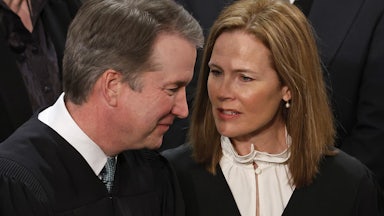Judge James Ho has one of the best jobs in the world right now. Thanks to the quirks of federal case assignment rules and the winds of political fate, he gets to serve on the Fifth Circuit Court of Appeals while it, in turn, serves as a junior varsity Supreme Court. The Fifth Circuit gets all of the fun of handing down sharply conservative rulings with none of the blowback that comes with being the final say on the matter.
The problem here is not that there are conservative judges and conservative courts. Those exist all over the country; they are a natural occurrence in a politically and ideologically diverse nation. You can also find them in the Sixth, Seventh, Ninth, and Eleventh Circuits as well. But the Fifth Circuit and the Texas federal courts are fundamentally different. They are structured to ensure that right-wing litigants almost always win, and everyone else must face an uphill battle against them.
In a recent speech for a local bar association in Texas, Ho derided the possibility that there could be legitimate criticism of the conservative legal establishment’s pipeline for right-wing rulings. He dismissed any criticism of the Texas federal courts’ rules as unfounded, biased, and dangerous to the integrity of the federal judiciary. In doing so, he also showed why deeper structural reforms should be considered.
The Judicial Conference of the United States, the federal courts’ policymaking body, tried to do something about this state of affairs last month. Generally speaking, cases are assigned to judges based on the division of the district in which they serve. This can be abused in divisions where only a single judge is assigned, effectively allowing plaintiffs to pick their judge.
The conference’s proposal would require cases to be assigned at random from among all of the judges in a certain district in certain circumstances. After receiving intense criticism from Republican politicians and conservative legal figures, the conference instead suggested the proposal would be nonbinding guidance that lower courts could freely ignore.
Ho nonetheless framed the whole thing as an attack on rural litigants who might be forced to travel to big cities to have their cases heard. “If the Judicial Conference proposal is adopted, a citizen of Midland who seeks relief will likely be forced to litigate before a judge who lives hundreds of miles away,” he claimed. “The same is true with the single-judge division in Amarillo—the division that has received the sharpest political criticism. Under this proposal, citizens in the Panhandle will more likely than not be forced to litigate their rights before a federal judge 400 miles away in Dallas.”
This is a bit of a stretch. The Judicial Conference said its proposal would only affect a subset of civil cases that “seek to bar or mandate state or federal actions, ‘whether by declaratory judgment and/or any form of injunctive relief.’” It would not affect the lion’s share of litigation in a particular district. Nor would it affect criminal cases at all, where long travel distances could legitimately burden a defendant’s constitutional rights.
What the proposal would imperil is the conservative legal establishment’s injunction-industrial complex. Here is how it works: First, right-wing lawyers gin up some imaginary or threadbare plaintiffs. In the recent abortion drug case, for example, a group of anti-abortion doctors who billed themselves as the Alliance for Hippocratic Medicine, or AHM, claimed they had standing to challenge the FDA’s approval of the drug in part because of the “aesthetic injury” they had suffered. That specious argument persuaded Ho himself when the case made its way to the Fifth Circuit.
“Unborn babies are a source of profound joy for those who view them,” Ho wrote. “Expectant parents eagerly share ultrasound photos with loved ones. Friends and family cheer at the sight of an unborn child. Doctors delight in working with their unborn patients—and experience an aesthetic injury when they are aborted.” This is not how Article III standing works in the federal courts, to put it mildly.
Then they get their judge. Texas makes it pretty easy for them. It has a few districts where its divisions have only a single judge. AHM was able to guarantee that its case would be heard by Judge Matthew Kacsmaryk, an anti-abortion fellow traveler, by filing its lawsuit in the Amarillo division of the Northern District of Texas. Few federal judges would be as sympathetic to their cause as him; few judges, it seems, would be as willing to overlook their lawsuit’s procedural and legal flaws.
Then they get their ruling. Kacsmaryk ruled in AHM’s favor and overturned the FDA’s approval of mifepristone, issuing a nationwide injunction against the FDA. That’s the beauty of this system: With a nationwide injunction, one litigant in one court can achieve a national policy change without winning a single election or holding a single vote in Congress. Sure, the appellate courts sometimes block those injunctions from going into effect. But sometimes they don’t.
This process happens time and time again in the Fifth Circuit: in immigration cases, in LGBTQ rights cases, in cases challenging new federal regulations or Biden administration policy initiatives. Sometimes the state of Texas files the lawsuit instead of private plaintiffs; sometimes they both file them. And while a certain amount of legal showdowns are inevitable nowadays with any presidential administration, the deeply conservative judicial bench in Texas and the conservative supermajority on the Supreme Court means that the outcomes are deeply asymmetrical.
To all this, Ho says: Nonsense, everything is going fine! It’s those who question this system who are the real problem. “Look, I get what the critics are doing,” he said. “This isn’t about forum shopping. It’s about forum shaming. It’s about shaming judges who won’t distort their rulings to do their bidding—while rewarding those judges who do.”
He compared the single-judge divisions to a small, “one-stoplight” town in Texas with a single grocery store. “Now, do I immediately assume that something illegal or untoward has happened, just because there’s only one supermarket?” Ho said. “Some blatant violation of federal antitrust law? Of course not. It just means the town only needs one grocery store—not two. And just as one grocery store doesn’t mean monopolization, one federal district judge doesn’t mean corruption.”
Gauzy appeals to Americana aside, Ho’s metaphor is actually fairly apt: The “customers” seem to walk into the grocery store with a shopping list and typically get everything—or almost everything—they want. That’s great when it’s a grocery store. It is less than ideal for federal courts, which typically operate under the premise that the judge is a neutral arbiter of the law instead of a Pez dispenser for ideological rulings.
Ho disagreed and found the entire premise to be suspicious. “It’s the same thing when critics accuse certain Supreme Court justices of being unethical,” Ho continued. “They don’t attack other justices who engage in the same behavior—they applaud them, because they like their rulings. At the end of the day, there’s really just one ethics rule that applies: You’re unethical if you’re a principled originalist.”
This is a convenient way to brush aside any criticism. It is unsurprising that he defended Thomas here. Ho is a former Thomas clerk and, by all accounts, a friend of the justice. Thomas even administered the oath of office when Ho was sworn in as a federal appellate judge in 2018. Rather than take the oath at a courthouse or his own residence, Ho opted for the private library of Harlan Crow, the conservative billionaire whose lavish vacations with Thomas drew scrutiny and criticism last year. The conservative legal establishment is a big club, and you’re not in it.
His defenses of forum shopping on the actual merits are also unpersuasive. Most of his speech focused on forum shopping in bankruptcy and patent cases, which is a legitimate problem. Ho claimed, however, that the Fifth Circuit’s critics are disingenuous because they don’t want to reform these problems as well. Jay Willis, a legal columnist at Balls and Strikes, described this as “an archetypical example of whataboutism” and noted that Ho “offers no evidence for the proposition that opponents of forum shopping are also outspoken defenders of forum selling.”
Beyond that, Ho focused more on ideological grievances than substantive defenses. He even took a swipe at Chief Justice John Roberts for failing to rush to their aid. In 2018, Roberts famously rebuked former President Donald Trump’s criticism of specific federal judges by declaring that there are no “Obama judges or Trump judges,” describing them as “an extraordinary group of dedicated judges doing their level best to do equal right to those appearing before them.”
“You can’t proclaim that ‘we do not have Obama judges or Trump judges’—but only speak up when it’s an Obama judge who is criticized,” Ho argued. “If you do that, then you’re announcing that we do have Obama judges and Trump judges—because you’re only willing to defend one, and not the other.” If Ho is suggesting that he will be a “Trump judge” because people criticize him and the chief justice doesn’t specifically defend him, then my guess is that he was a “Trump judge” all along.
Indeed, there is an almost Trumpian unwillingness among conservative judges these days to treat any criticism or scrutiny as legitimate. Justice Samuel Alito claimed in 2021 that use of the term “shadow docket” to describe the court’s motions docket “feeds unprecedented efforts to intimidate the court and to damage it as an independent institution.” (The term was coined by an originalist legal scholar.) And while Thomas himself has been mostly quiet about recent ethics foibles, his proxies have cast those concerns as a leftist plot to remove him from the court.
Heavy is the head that wears the crown. The conservative legal establishment has engineered a Supreme Court supermajority and a friendly Fifth Circuit without a popular, democratic mandate. Trump appointed three Supreme Court justices despite losing the popular vote in 2016. Right-wing legal groups are using those courts to achieve major nationwide policy changes, again without passing a law or holding an election. Did they really think there wouldn’t be any pushback along the way? Did they really think they would escape any criticism for this?
Ho is absolutely correct about one thing: Congress has the power to force the federal judiciary to make reforms here. And since the judiciary itself might not fix the problem, Congress would be perfectly justified in stepping in. One solution would be to mandate the Judicial Conference’s rule by legislation, which would make it harder for right-wing judges in Texas to circumvent it. This would address the most immediate problem that led to situations like the Kacsmaryk one.
But a more durable solution would be to make sure there are no single-judge divisions in the country at all. Congress, after all, has the power to create additional judicial seats when it so desires. I’ve written before on how there seems to be a dearth of judgeships in Texas in particular, in no small part because of the state’s high population growth. The state added almost four million residents between the 2010 and 2020 censuses—the equivalent of the entire states of Idaho and Nebraska.
There’s a shortage of federal judges across the country in general right now. Congress has not added a significant number of new judgeships since 1990, meaning that the federal judiciary has gone nearly 35 years without population or workload adjustments. The Judicial Conference recommended last year that Congress add 66 new judgeships to address the problem, including 13 new district court judges in Texas itself. Congress could even ensure that those judgeships are added in a way that ensures no division in Texas has just one district court judge assigned to it.
It’s worth noting here that the Judicial Conference is not a group of left-wing policy wonks. It consists of federal judges from across the country, whose work is chaired by the chief justice himself. (That may explain Ho’s unnecessary swipe at Roberts.) If the right-wing legal pipeline in Texas can’t abide criticism or reform suggestions from even this most neutral of internal observers, then reforms should come from outside as well. A small town with a single grocery store, to borrow Ho’s metaphor, could always use a second one.










